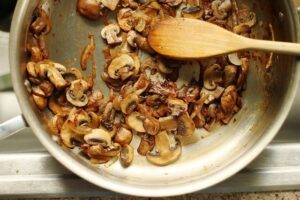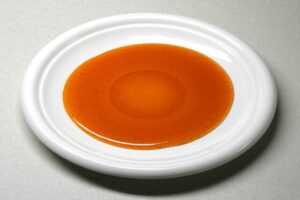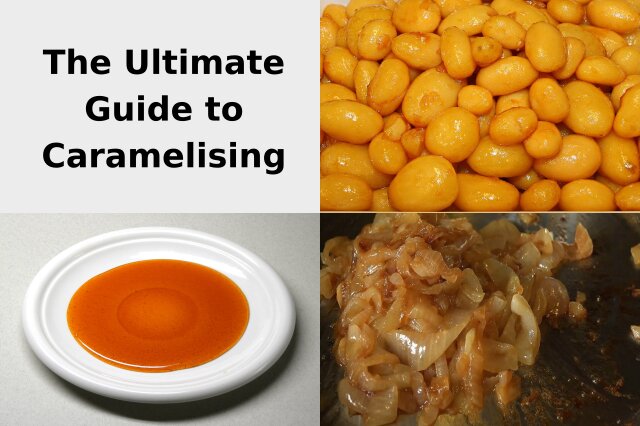Caramelisation is a cooking technique that involves heating sugar until it turns into a rich, golden-brown liquid. This process can add a depth of flavour and complexity to both sweet and savoury dishes.
Whether you’re a seasoned chef or a beginner in the kitchen, our expert tips and delicious recipes will help you master the art of caramelising.
The Art of Caramelising:
Techniques and Recipes

When it comes to cooking and baking, caramelisation is a crucial process that brings depth of flavour and colour to many dishes.
However, it is often misunderstood or underused due to lack of knowledge.
To bring light to this essential culinary technique, I present to you “Everything You Need to Know About Caramelizing.”
This comprehensive guide will take you through the science behind caramelisation, different methods, equipment, common mistakes, troubleshooting tips, as well as delicious recipe ideas to try at home.
Understanding the Science of Caramelisation.
Caramelisation is a chemical reaction that occurs when sugar is heated to a high temperature. As the sugar molecules break down, they form new compounds that give caramel its characteristic flavour and colour.
The process involves both the Maillard reaction, which creates complex flavour compounds, and the breakdown of sugar molecules, which creates caramel’s signature sweetness.
Understanding the science behind caramelisation can help you achieve the perfect caramel every time.
Choosing the Right Pan and Heat Source.
When it comes to caramelisation, choosing the right pan and heat source is crucial.
A heavy-bottomed pan, such as a cast iron skillet or stainless steel pan, is ideal for even heat distribution and preventing hot spots.
Avoid using non-stick pans, as they can inhibit the caramelisation process.
As for heat source, a gas stove is preferred over an electric stove, as it allows for more precise temperature control.
However, if using an electric stove, choose a pan with a thick bottom to help distribute heat evenly.
Preparing Your Ingredients for Caramelisation.
Before you start caramelising, it’s important to prepare your ingredients properly.
For fruits and vegetables, make sure they are sliced or diced evenly to ensure even cooking and caramelisation.
For meats, pat them dry with a paper towel to remove excess moisture, which can inhibit caramelisation.
Additionally, adding a pinch of salt to your ingredients before cooking can help draw out moisture and enhance flavour.
Finally, make sure your ingredients are at room temperature before cooking, as cold ingredients can lower the temperature of the pan and slow down the caramelisation process.
Mastering the Caramelisation Process.
Caramelisation is a cooking technique that involves heating sugar or other carbohydrates until they turn brown and develop a rich, nutty flavour.
To master the caramelisation process, it’s important to use the right tools and techniques. Start by using a heavy-bottomed pan, which will distribute heat evenly and prevent burning.
Next, use a medium-high heat and avoid stirring too frequently, as this can prevent caramelisation from occurring.
Finally, be patient and allow the caramelisation process to happen naturally, without rushing or forcing it.
With practice and patience, you can become a master of caramelisation and add depth and flavour to your cooking.
Delicious Caramelisation Recipes to Try at Home.
Ready to put your caramelisation skills to the test? Try these delicious recipes at home and impress your friends and family with your culinary prowess. From sweet treats like caramelised banana bread to savoury dishes like caramelised onion tart, there’s something for everyone to enjoy.
Don’t be afraid to experiment with different ingredients and flavours to create your own unique caramelised creations. Happy cooking!
- Caramelised Onion Tart.
- This recipe is perfect for a savoury caramelisation dish.
Start by caramelising sliced onions in a pan with butter and sugar until they are golden brown.Then, spread the onions over a pre-made pastry crust and top with grated cheese and herbs.
Bake in the oven until the crust is golden brown and the cheese is melted.
- Caramelised Bananas.
- For a sweet caramelisation recipe, try caramelising bananas.
Cut bananas into slices and toss them in a mixture of brown sugar and butter.
Cook the bananas in a pan until they are golden brown and caramelised.Serve over ice cream or pancakes for a delicious dessert.
- Caramelised Carrots.
- Caramelised carrots are a great side dish for any meal.
Cut carrots into thin slices and cook them in a pan with butter and brown sugar until they are caramelised.Add a sprinkle of salt and pepper for extra flavour.
- Caramelised Brussels Sprouts.
- Brussels sprouts are often disliked, but caramelising them can change that.
Cut the Brussels sprouts in half and cook them in a pan with butter and brown sugar until they are caramelised and tender.Add a sprinkle of salt and pepper for extra flavour.
- Caramelised Pork Chops.
- For a savoury main dish, try caramelising pork chops.
Season the pork chops with salt and pepper and cook them in a pan with butter and brown sugar until they are caramelised and cooked through.Serve with a side of caramelised onions or carrots for a complete meal.
- Caramelised Apples.
- Caramelised apples are a delicious dessert that can be served on their own or with ice cream.
Cut apples into slices and cook them in a pan with butter and brown sugar until they are caramelised and tender.Add a sprinkle of cinnamon for extra flavour.
- Caramelised Sweet Potatoes.
- Sweet potatoes are a great vegetable to caramelise.
Cut the sweet potatoes into cubes and cook them in a pan with butter and brown sugar until they are caramelised and tender.Add a sprinkle of salt and pepper for extra flavour.
How to Caramelise Vegetables
 Caramelizing vegetables can enhance their natural sweetness and add depth of flavour to dishes.
Caramelizing vegetables can enhance their natural sweetness and add depth of flavour to dishes.
It also creates a crispy texture on the outside while keeping the inside tender.
Additionally, caramelized vegetables can be a healthier alternative to fried foods as they require less oil and retain more nutrients.
Follow these simple steps.
- Choose the right vegetables;
Not all vegetables are suitable for caramelization.
Vegetables that are high in natural sugars, such as carrots, onions, sweet potatoes, leeks and capsicum/bell peppers, are perfect for caramelization. - Cut the vegetables into even pieces;
To ensure even cooking and caramelization, it’s important to Dice the vegetables into even pieces.
This will also help them cook evenly at the same rate. - Use a heavy-bottomed pan;
A large heavy-bottomed Frypan will distribute heat evenly and prevent hot spots, which can cause uneven caramelization. - Heat the pan before adding the vegetables;
To ensure a good sear and caramelization, heat the pan over medium-high heat before adding the vegetables.
This will also prevent the vegetables from sticking to the pan. - Add a small amount of oil or butter;
Adding a small amount of oil or butter will help the vegetables caramelize and prevent them from sticking to the pan.
Use a neutral oil like vegetable or canola oil, or a flavourful oil like olive oil. - Don’t overcrowd the pan;
Overcrowding the pan will cause the vegetables to steam instead of caramelize.
Cook the vegetables in batches if necessary. - Season the vegetables;
Season the vegetables with salt and pepper before cooking.
You can also add herbs and spices for extra flavour. - Cook the vegetables until caramelized;
Cook the vegetables over medium-high heat until they are caramelized and tender.
This can take anywhere from 10 to 20 minutes, depending on the vegetable and the size of the pieces. - Deglaze the pan;
After cooking the vegetables, deglaze the pan with a liquid like wine, broth, or vinegar.
This will help loosen any caramelized bits and create a flavourful sauce. - Serve and enjoy!;
Caramelized vegetables are delicious on their own or as a side dish. Serve them hot and enjoy their sweet, savoury flavour.
How to caramelise sugar
 Learn how to caramelise sugar for candy and confection recipes or just to make yourself a chewy, warm, delicious treat!
Learn how to caramelise sugar for candy and confection recipes or just to make yourself a chewy, warm, delicious treat!
- Choose the right type of sugar;
Granulated white sugar is the most commonly used sugar for caramelizing.
However, you can also use brown sugar, coconut sugar, or even honey for a different flavour profile. - Use a heavy-bottomed pan;
A heavy-bottomed pan will distribute heat evenly and prevent the sugar from burning.
A non-stick pan is not recommended as it can cause the sugar to crystallize. - Add a small amount of water;
Adding a small amount of water to the sugar before heating can help prevent it from burning.
Use about 1 tablespoon of water per cup of sugar. - Heat the sugar slowly;
Heat the sugar over low to medium heat, stirring constantly until it begins to melt.
Once it starts to melt, you can increase the heat slightly. - Do not stir too much;
While it is important to stir the sugar constantly, do not overdo it.
Too much stirring can cause the sugar to crystallize. - Watch the colour;
As the sugar melts and caramelizes, it will turn a golden brown color.
Keep a close eye on it as it can quickly go from caramelized to burnt. - Add butter or cream;
Once the sugar has caramelized to your desired colour, you can add butter or cream to create a caramel sauce.
Be careful as the mixture will bubble and steam. - Use caution;
Caramelized sugar is extremely hot and can cause serious burns.
Use caution when handling and allow it to cool before tasting or using in a recipe.
How to caramelise onions like a pro.
Follow these simple steps for perfect caramelised onions every time!
Once onions are nice and caramelized you can use them to make french onion soup, put it on hot dogs and burgers, have with a good Beef steak, or just have it by itself.
Ingredients
- 4 large onions
- oil
- salt
Instructions
- Choose the right onions;
The best onions for caramelising are sweet onions, such as Vidalia, Walla Walla, or Maui onions.
These onions have a higher sugar content and will caramelise more easily.
In Australia and New Zealand, the most popular onions for caramelizing are brown onions and red onions.
Brown onions have a strong, pungent flavour that mellows out when caramelized, while red onions have a slightly sweeter taste that also works well when caramelized. - Slice the onions thinly;
Thinly sliced onions will cook more evenly and caramelise faster.
Use a sharp knife or a mandoline to slice the onions into thin, even slices. - Heat the pan;
Use a large heavy-bottomed pan, such as a cast iron skillet, and heat it over medium-high heat.
Add a tablespoon of oil or butter to the pan and let it melt. - Add the onions;
Add the sliced onions to the pan and stir to coat them in the oil or butter.
Spread them out evenly in the pan. - Season the onions;
Add a pinch of salt and pepper to the onions to enhance their flavour.
You can also add herbs or spices, such as thyme or cumin, for extra flavour. - Cook the onions;
Cook the onions over medium-high heat, stirring occasionally, until they start to soften and turn golden brown.
This can take anywhere from 15 to 45 minutes, depending on the amount of onions, the thickness of the onions and the heat of the pan. - Add liquid;
If the onions start to stick to the pan or burn, add a splash of liquid, such as water, broth, or wine, to deglaze the pan and prevent burning. This will also add extra flavour to the onions. - Continue cooking;
Continue cooking the onions, stirring every couple of minutes, until they are deep golden brown and caramelised.
They should be soft and sweet, with a rich, complex flavour. - Serve and enjoy;
Caramelised onions are a delicious addition to many dishes, such as burgers, sandwiches, pizzas, and salads.
They can also be used as a topping for soups or stews, or as a flavourful side dish. Enjoy!

